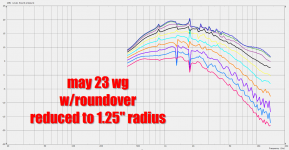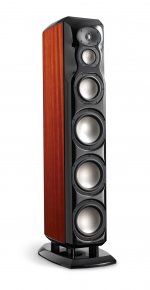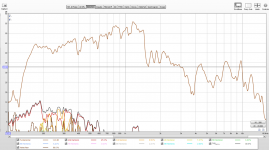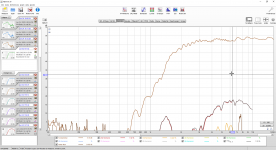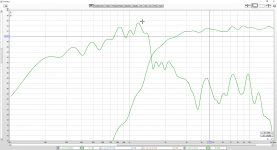Here's the exact same waveguide as post 159, but with the roundover reduced from 44mm to 30mm radius.
The difference is really subtle - but it's measurably worse.
A big ol' roundover really seems to do a lot, so I think I may try an MTM with a smaller waveguide and a giant roundover.
The difference is really subtle - but it's measurably worse.
A big ol' roundover really seems to do a lot, so I think I may try an MTM with a smaller waveguide and a giant roundover.
Attachments
With a sphere you'd get rid of diffraction altogether. As long as you approximate a sphere reasonably well the diffraction is minimized. Roundover radius can be small or big as long as the roundover starts immediately beside the transducer /waveguide giving better approximation of sphere, otherwise the radius is too small. In other words minimal flat baffle area gives best performance for any given edge radius. Bigger edge radius is better than small, but is harder to manufacture. Luckily the performance is already good even with small radius as long as it starts immediately beside the transducer /waveguide.
Wiggle on the frequency response is just that, another sound source interacting with direct sound making interference. Reduce the diffraction, the secondary source, and the frequency response shows less wiggle.
Wiggle on the frequency response is just that, another sound source interacting with direct sound making interference. Reduce the diffraction, the secondary source, and the frequency response shows less wiggle.
Here's the exact same waveguide as post 159, but with the roundover reduced from 44mm to 30mm radius.
The difference is really subtle - but it's measurably worse.
A big ol' roundover really seems to do a lot, so I think I may try an MTM with a smaller waveguide and a giant roundover.
Probably you've mentioned this before when stating the differences between the various ranges of the Revel speakers, the Salon 2 has large round overs starting right from the waveguide towards the edges of the front baffle, whereas the Performa 328Be has some part of the flat baffle beyond the waveguide.
Jim Garret of Harman also mentions that the diffraction characteristics of the Salon 2 are superior vs the Performa 328Be, though the Performa has advantages in other areas, due the new technologies and know how Harman could implement in the 12 year newer design.
Attachments
Apart from changes in the numerical instabilities which are not real and the thicker traces highlighting those instabilities I see no real difference.Here's the exact same waveguide as post 159, but with the roundover reduced from 44mm to 30mm radius.
The difference is really subtle - but it's measurably worse.
A big ol' roundover really seems to do a lot, so I think I may try an MTM with a smaller waveguide and a giant roundover.
I took another crack at making a Unity horn that's basically embedded inside of a cylinder.
I think it was over on the ATH thread that somebody suggest using a sphere to reduce diffraction. Trying to make a sphere turned out to be impractical (I tried) so I settled on a cylinder.
One of the big changes here, versus my prior designs, is that the overall diameter of the cylinder is 400mm (16")
This was "do-able" because I realized that you can take a 12" sonotube, slice it vertically, and turn it into a 16" cylinder by using a waveguide that spans ninety degrees of the cylinder.
I think it was over on the ATH thread that somebody suggest using a sphere to reduce diffraction. Trying to make a sphere turned out to be impractical (I tried) so I settled on a cylinder.
One of the big changes here, versus my prior designs, is that the overall diameter of the cylinder is 400mm (16")
This was "do-able" because I realized that you can take a 12" sonotube, slice it vertically, and turn it into a 16" cylinder by using a waveguide that spans ninety degrees of the cylinder.
Attachments
-
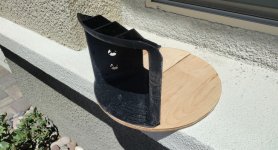 IMG_20220624_110504.jpg183.3 KB · Views: 122
IMG_20220624_110504.jpg183.3 KB · Views: 122 -
 IMG_20220624_110458.jpg120.5 KB · Views: 126
IMG_20220624_110458.jpg120.5 KB · Views: 126 -
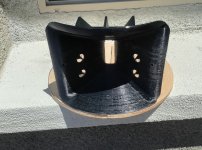 IMG_20220624_110453.jpg237.6 KB · Views: 126
IMG_20220624_110453.jpg237.6 KB · Views: 126 -
 IMG_20220624_110507.jpg166.8 KB · Views: 118
IMG_20220624_110507.jpg166.8 KB · Views: 118 -
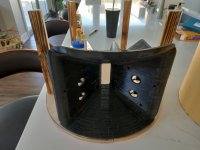 IMG_20220624_165723.jpg308.5 KB · Views: 113
IMG_20220624_165723.jpg308.5 KB · Views: 113 -
 IMG_20220624_165735.jpg230 KB · Views: 125
IMG_20220624_165735.jpg230 KB · Views: 125 -
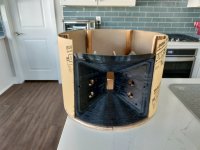 IMG_20220624_165938.jpg290.8 KB · Views: 132
IMG_20220624_165938.jpg290.8 KB · Views: 132 -
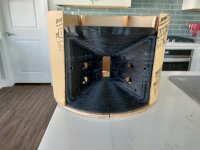 IMG_20220624_165940.jpg335.2 KB · Views: 143
IMG_20220624_165940.jpg335.2 KB · Views: 143
Here's the distortion and horizontal polars of the midbasses alone.
I did these first because the high frequency extension of the midbass will determine whether the design is possible or not. Basically if the midbass can't reach about 1500Hz, the design won't work.
It looks like it will, so that's good. But it's admittedly tight (fingers crossed.)
Another thing that's important here, is that the midbasses AREN'T beaming, until 1800Hz. This is important because the midbasses are mounted horizontally.
The overall roughness of the response is because I did a quick and dirty ground plane measurement, with a long gate. Once I get the time to mount the tweeter and measure it off the ground, response should be smoother.
I did these first because the high frequency extension of the midbass will determine whether the design is possible or not. Basically if the midbass can't reach about 1500Hz, the design won't work.
It looks like it will, so that's good. But it's admittedly tight (fingers crossed.)
Another thing that's important here, is that the midbasses AREN'T beaming, until 1800Hz. This is important because the midbasses are mounted horizontally.
The overall roughness of the response is because I did a quick and dirty ground plane measurement, with a long gate. Once I get the time to mount the tweeter and measure it off the ground, response should be smoother.
Attachments


Here's the polar and distortion measurement of the Airborne RT-5002 AMTs that I'm using, from a project I did last year: https://www.diyaudio.com/community/threads/the-nightmare-before-labor-day.374570/post-6799374
As with any two-way Unity Horn project, the tricky part is getting the midbasses to play high AND low. I'm making things extra difficult for myself by using an AMT lol
My thought process here, is that I tried a dozen different ways to limit the vertical directivity, but it's tough to beat a ribbon, planar or AMT for that:
1) Paralines have limited vertical directivity, and I built some new ones a few months ago, but the response was rough: https://www.diyaudio.com/community/threads/square-pegs.217298/post-6978174
2) If you can live with broad vertical directivity, a dome or compression driver will work fine. But the Airborne AMT is generally smoother than both, and smooth treble response is proven to sound ideal. Also, the CSD of AMTs is tough to beat.

This is the speaker from last September. If you look at the frequency response of the AMT, you'll note that there's a GIANT "step" in efficiency at 2khz.
https://meniscusaudio.com/wp-content/uploads/2015/11/RT5002-Data-Sheet.pdf
In the spec sheet, the "step" is at 3khz.
I have no idea why it never occurred to me until this morning, but that "step" is because the wavefront is becoming spherical. (Why didn't I realize that last year???)
Basically the "stock" ribbon has a vertical opening that's 100mm tall. 3400Hz is 100mm long. So what's happening is that the AMT can still play down, possibly to even 1khz, but when it radiates spherically you basically have to double the input power to compensate for the wavefront being spherical. Above 3400Hz, the wavefront is planar, causing the efficiency to be higher.
The mouth of the waveguide from last year was about 175mm tall, which is why the "step" began at 2khz. (2khz is 175mm long.)
The mouth of the NEW waveguide is 230mm tall, so if I'm "lucky" then the "step" may not begin until about 1500Hz. Which would be fantastic, because it means I wouldn't need to use a ton of EQ to "fight" the "step" like I did in the speaker from last year. (If you look at the EQ settings posted above, I was using a whopping +12dB of EQ in the octave from 1-2khz, and you can see that impacted the distortion performance, manifesting itself as 2nd harmonic distortion from 2-4khz.
Basically, if I can avoid using tons of EQ from 1-2khz, it should increase power handling by about 1000% and lower distortion by about 10dB.
If this helps I'll pass it along. Aurum Cantus makes one of the better sounding AMT's. I did a lot of design work on AMTS a few years back and I am starting again. The one you are using is not the greatest. I am guessing that you are in proof of concept phase. So this is information for you back pocket. When and or if.
I thought the main issue with Airborne is quality control?
I know that Oskar on this forum created some mods to lower the distortion level. But my RT-5002s appear to be epoxied together and I'm not keen on prying them apart.
I know that Oskar on this forum created some mods to lower the distortion level. But my RT-5002s appear to be epoxied together and I'm not keen on prying them apart.
For comparison's sake, here's the $182 Aurum Cantus AST 2560:

And here's the $118 Airborne RT-5002:

Note that my measurement is equalized, and the AC measurement isn't. I'm hoping I can reduce the amount of EQ with a much bigger waveguide. The new one is more than twice as large.
The Aurum Cantus AMT is flatter in response and has wider bandwidth. It's also 54% more expensive. The Aurum Cantus is about 3-5dB less efficient.
To me, I get the impression that the folks at Airborne basically chased a high efficiency spec, which impacted how low it could play. My fingers are crossed that my big ol' waveguide compensates for the efficiency "step" at 3khz, where efficiency drops by 10dB because the wavefront is becoming spherical.
And here's the $118 Airborne RT-5002:

Note that my measurement is equalized, and the AC measurement isn't. I'm hoping I can reduce the amount of EQ with a much bigger waveguide. The new one is more than twice as large.
The Aurum Cantus AMT is flatter in response and has wider bandwidth. It's also 54% more expensive. The Aurum Cantus is about 3-5dB less efficient.
To me, I get the impression that the folks at Airborne basically chased a high efficiency spec, which impacted how low it could play. My fingers are crossed that my big ol' waveguide compensates for the efficiency "step" at 3khz, where efficiency drops by 10dB because the wavefront is becoming spherical.
Yeah, the driver doesn't have the motor to drive it much below ~3 kHz, so going to be a typical sub tuned < Fs situation of trading a lot of efficiency for BW, so with no ribbon/planer experience, curious how much a relatively huge air mass 'plug' will roll off its upper BW.
I measured so many AMT's when we were doing the R&D I can tell you a few points. Anything that is yellow is polyester. It can have nasty peaks in the response and distortion that is very noticeable in the places you want it the least! The Aurum Cantus, whom I have no affiliation with at all is not made from polyester. They use something else. It took a while to figure it out. It is much heavier than the normal AMT diaphragm. As for Hygiea (Airborne is made by Hygeia) having quality problems, it is epic unit to unit is all over the place.For comparison's sake, here's the $182 Aurum Cantus AST 2560:

And here's the $118 Airborne RT-5002:

Note that my measurement is equalized, and the AC measurement isn't. I'm hoping I can reduce the amount of EQ with a much bigger waveguide. The new one is more than twice as large.
The Aurum Cantus AMT is flatter in response and has wider bandwidth. It's also 54% more expensive. The Aurum Cantus is about 3-5dB less efficient.
To me, I get the impression that the folks at Airborne basically chased a high efficiency spec, which impacted how low it could play. My fingers are crossed that my big ol' waveguide compensates for the efficiency "step" at 3khz, where efficiency drops by 10dB because the wavefront is becoming spherical.
As you probably know Greg, the B in the gap is small. And that is pretty much how it works. Even with substantially greater B available the way an AMT works is that there is very little L. Very little actual voice coil. And the stronger motor can do some interesting things to the response.Yeah, the driver doesn't have the motor to drive it much below ~3 kHz, so going to be a typical sub tuned < Fs situation of trading a lot of efficiency for BW, so with no ribbon/planer experience, curious how much a relatively huge air mass 'plug' will roll off its upper BW.
Measured in kilogauss The far left is the standard motor that we did for PE back in 2014.
Nothing fancy for measurements. In a lab, comparative only. The measurements were made at 1.5 metres. Lower trace is purple and the strongest motor. We offset it a bit. But you get the idea. To much B will dampen the response in some areas and peak it in others. The AMT diaphragm is basically both the damper and the diaphragm. And that can be a tough nut to balance. You will notice in the Aurum Cantus measurement the bandwidth is greater. I can tell you that the mass is higher, the diaphragm is substantially more compliant and the B field is higher. It is a balanced design. You get what you pay for. Mundorf is the only AMT that actually uses Kapton and you can see the resonances for yourself. Even if we did nearfield measurements it was very apparent.
Thought I'd share a little bit of what goes on in the real world of speaker design. It's not all Computers and simulations. I like to get my hands dirty too!
Thank you for the insight on AMTs!
Would you consider the Parts Express AMT PROs to be competitive, or should I use Aurum Cantus?
Would you consider the Parts Express AMT PROs to be competitive, or should I use Aurum Cantus?

Here's the polar response of the AMT in the enclosure. Looking pretty darn good if I do say so myself. These measurements are from zero to 45 degrees off axis in 7.5 degree increments.
I was aiming for a beamwidth of 90 degrees and it ended up being about 80 degrees, which I can live with.
I need to upload the filter settings. This response is equalized.

One of the great things, was that the design didn't require a ton of EQ to bring up the low end. As described in my post five days ago, the AMT requires a relatively large waveguide to prevent the wavefront from expanding spherically. Basically if the waveguide isn't large enough, your efficiency will drop like a rock.
Distortion peaks at about two percent at 6khz, mostly second harmonic. TBF, AMTs like the SB Acoustics Satori have lower distortion, but also cost more than twice as much. One big criteria for me in this project was excellent polar response, and big wide AMTs like the SB Acoustics beam quite badly. That could be a feature or a defect depending on how you see things, but I wanted something with wide-ish beamwidth.
https://audioxpress.com/article/test-bench-the-at60nc-4-amt-tweeter-from-sb-acoustics-satori-line
https://www.madisoundspeakerstore.com/amt/satori-at60nc-4-amt-tweeter/ Satori AT60NC-4 AMT Tweeter
Attachments
I'm using two MCM 55-1870 midbasses in this speaker.

The waveguide is about 18cm deep. This generates some "horn loading" from about 472Hz on up. (1888Hz is 18cm long.)
Normally I would just roll off the gain using a filter, and that would create an easy load for the amplifier and it would also give me some additional headroom in the midrange.
But an idea I've had, is to add an additional pair of midbasses to the speaker, perhaps located on the back of it. Here's my thought process:
1) The size of the speaker was basically dictated by the size of the waveguide. I didn't choose to use an enclosure that's 40cm wide for the lulz, I chose that size because I wanted to control directivity as low as possible while still having decent WAF. I couldn't go much smaller than that, because if I did, the midbasses wouldn't fit on the waveguide. I considered using smaller midbasses, but the issue I kept running in to was that smaller midbasses dramatically limited my SPL. A five inch midbass was basically the smallest I could use while achieving my SPL goals.
2) But due to the fact that the speaker is 40cm in diameter, I have a lot more airspace than needed.
So I'm tinkering with the idea of adding two more midbasses to the enclosure, but only running them up to about 500Hz.
So it would still be a Unity Horn, but it would be a 2.5way. I don't think anyone's every done that.
Obviously, I could also go with a three way.
I'll need to run some sims and see if two more MCM 55-1870s works better, or if an additional woofer works better. Perhaps something like the Dayton DC200.

The waveguide is about 18cm deep. This generates some "horn loading" from about 472Hz on up. (1888Hz is 18cm long.)
Normally I would just roll off the gain using a filter, and that would create an easy load for the amplifier and it would also give me some additional headroom in the midrange.
But an idea I've had, is to add an additional pair of midbasses to the speaker, perhaps located on the back of it. Here's my thought process:
1) The size of the speaker was basically dictated by the size of the waveguide. I didn't choose to use an enclosure that's 40cm wide for the lulz, I chose that size because I wanted to control directivity as low as possible while still having decent WAF. I couldn't go much smaller than that, because if I did, the midbasses wouldn't fit on the waveguide. I considered using smaller midbasses, but the issue I kept running in to was that smaller midbasses dramatically limited my SPL. A five inch midbass was basically the smallest I could use while achieving my SPL goals.
2) But due to the fact that the speaker is 40cm in diameter, I have a lot more airspace than needed.
So I'm tinkering with the idea of adding two more midbasses to the enclosure, but only running them up to about 500Hz.
So it would still be a Unity Horn, but it would be a 2.5way. I don't think anyone's every done that.
Obviously, I could also go with a three way.
I'll need to run some sims and see if two more MCM 55-1870s works better, or if an additional woofer works better. Perhaps something like the Dayton DC200.
The Arum Cantus uses a very high loss diaphragm material. So breakups that you see with the Kapton and the Polyester that you can see in the graphs are real. I hear them. Even the one that I designed! Terrible for a designer not to like his baby. I did design a considerably cleaner sounding AMT than the Mundorf but not as clean as the Arum Cantus. I have sat for a few hours in front of mine and not wanted to run out of the room. But I still hear them. The pro versions from Parts express is more efficient. If that is important then you choose. If fidelity is important Aurum Cantus or ELAC also makes a really well designed AMT. If you can get one of those. Have you considered a pro planar like AKIP? PA106 is a great sounding planar. Speakersandamps.com sells them.Thank you for the insight on AMTs!
Would you consider the Parts Express AMT PROs to be competitive, or should I use Aurum Cantus?
I put them into these for Funk Audio:
@Patrick Bateman is your current preference for narrow vertical dispersion a general preference or just due to your current reflective listening enviroment?
I think that if you can figure out how to accomplish it, narrow vertical directivity is ideal.
Basically any reflections off of the floor or ceiling are no good.
To me, one of the most dramatic examples of this is the Gradient Helsinki:

I heard these a few years back, and the near absence of sound from the floor and ceiling was eerie. I heard them at CES, where the acoustics are fairly awful. Yet even though the ceilings are "only" nine feet tall, the Helsinki sounded noticeably different than a conventional speaker. And I think a lot of that is because the first reflection is aimed so that it occurs quite a bit after the initial wavelaunch.
In other words -
In a conventional speaker, the midrange is mounted vertically, and the sound that's radiated into the floor and ceiling is fairly similar in output level to what's going FORWARD. Because of this, sound is radiating into the floor before it even reaches the listener.

Sound radiates into the floor, ceiling and back wall before it even reaches the listener.

With the Helsinki, there isn't much sound radiated into the floor at all, and the sound that hits the ceiling takes a while to get there. By angling the baffle it increases the pathlength by about 41%.
The subwoofer is a dipole, and the dipole's null is aimed right at the back wall, with an intention to reduce excitation of that surface.
But before anyone runs out and makes a Helsinki clone, keep in mind that it has an Achilles Heel, which is that the maximum output is not great. It has a sensitivity of 84dB and a power handling of about 100 watts iirc: https://www.stereophile.com/content/gradient-helsinki-15-loudspeaker-measurements
Basically any reflections off of the floor or ceiling are no good.
To me, one of the most dramatic examples of this is the Gradient Helsinki:

I heard these a few years back, and the near absence of sound from the floor and ceiling was eerie. I heard them at CES, where the acoustics are fairly awful. Yet even though the ceilings are "only" nine feet tall, the Helsinki sounded noticeably different than a conventional speaker. And I think a lot of that is because the first reflection is aimed so that it occurs quite a bit after the initial wavelaunch.
In other words -
In a conventional speaker, the midrange is mounted vertically, and the sound that's radiated into the floor and ceiling is fairly similar in output level to what's going FORWARD. Because of this, sound is radiating into the floor before it even reaches the listener.

Sound radiates into the floor, ceiling and back wall before it even reaches the listener.

With the Helsinki, there isn't much sound radiated into the floor at all, and the sound that hits the ceiling takes a while to get there. By angling the baffle it increases the pathlength by about 41%.
The subwoofer is a dipole, and the dipole's null is aimed right at the back wall, with an intention to reduce excitation of that surface.
But before anyone runs out and makes a Helsinki clone, keep in mind that it has an Achilles Heel, which is that the maximum output is not great. It has a sensitivity of 84dB and a power handling of about 100 watts iirc: https://www.stereophile.com/content/gradient-helsinki-15-loudspeaker-measurements
- Home
- Loudspeakers
- Multi-Way
- The Nightmare Before Labor Day
